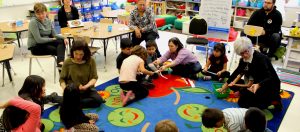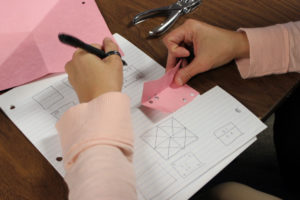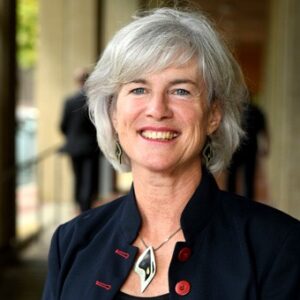Former Robertson Program Director Bev Caswell describes how an inclusive Professional Development model leads to the formation of relationships and makes math more accessible
When the Robertson Program conducted professional development (PD) around spatial reasoning, I had the pleasure of working with educators from across Ontario. We focused on developing young children’s spatial reasoning and geometric thinking, while making rich community connections through the site-based PD.
At times, our PD looked as you might imagine: educators gathered around a table, learning about mathematics. At other times, though, it looked much different. It was common to see 20+ educators gathered in a classroom to observe the children’s response to newly designed math activities. We’d excitedly return to the discussion room armed with real-life, in-class observations to further design and improve learning experiences for children.
PD included classroom teachers, administrators, educational assistants, specialty teachers, math leads, Indigenous language educators, community members, etc. Participants often commented on how refreshing it felt to have so many members of an education team involved. This model honours multiple perspectives, makes mathematics accessible to everyone at the table and it disrupts hierarchies creating systemic barriers to participation.

Dr. Bev Caswell engages in on-site professional development with educators and students at Onigaming First Nation School. The Robertson Program developed many engaging spatial activities with educators from Onigaming.
INDIGENOUS PERSPECTIVES IN MATH
Our work led to the opportunity to work alongside Indigenous educators who generously shared their perspectives on math. This culturally-based mathematical knowledge and experience would influence both the content we explored, and the means by which it was delivered.
A writing partnership emerged amongst myself and three educators: Rainy River District School Board Ojibwe Language Coordinator, Jason Jones (Nigigoonsiminikaaning First Nation), Kawartha Pine Ridge District School Board Equity and Inclusive Education Consultant Marjolaine Lapointe (Ardoch Algonquin First Nation), and Tracy Kabatay, Seine River First Nation Educational Councillor at the time.
In a chapter for the National Council of Teachers of Mathematics’ 2018 Annual Journal, we wrote about our experience working together in this unique professional development model. Our chapter exemplifies what is needed to bring transformative change in education: recognizing and honouring ways of knowing that may be different than one’s own, creating space for voices typically silenced, and creating space in which Indigenous and non-Indigenous educators shape the work together.
Authors take part in Book Study
For its 2020 book study, the California Mathematics Council (CMC) chose Annual Perspectives in Mathematics Education (APME): Rehumanizing Mathematics for Black, Indigenous, and Latinx Students[1].
In December, the CMC focussed on the chapter[2], co-authored by Bev Caswell (Former Director of the Robertson Programs), Jason Jones (Rainy River District School Board Educator), Marjolaine LaPointe (Kawartha Pine Ridge District School Board) and Tracy Kabatay (Rainy River District School Board Educator): We Don’t Think of It in Terms of Math, It’s Just the Way of Life. The authors recently presented their work to the California Mathematics Council (CMC), who chose the APME volume for their book study.
SPATIAL THINKING IS ENHANCED BY ANISHINAABEMOWIN
In our PD, Jason Jones shared how a dynamic spatial approach to math dovetails well with the verb-based Ojibwe language (Anishinaabemowin). He noted that Anishinaabemowin allows for mathematics to take on a more dynamic role, breathing life into a domain often seen as static. For example, the Anishinaabemowin word for rectangle, genoo-gakagaag is loosely translated as “an elongated square.” Jason highlights the relationship between a square and a rectangle, noting how their forms can be visualized with movement.
“It still wants to stay a verb, but it’s a noun-like verb,” he says. “Gak is a 90-degree angle and agaag is in a state or condition. It’s kind of like it’s moving, but at the same time it’s an object.”
Jason illustrates how the verb-based language influences ways of seeing the world. “Nothing really stands still if you think about it,” he says. The language promotes visualization, a key area in developing spatial thinking.
Jason says language is key in the understanding of math because it reveals ways of knowing and ways of experiencing the world.
Jason Jones explains how to count in Anishinaabemowin while at the Fall Harvest presented by Seven Generations Education Institute
Marjolaine Lapointe has come to understand the nuances of the Anishinaabemowin language from the multiple language teachers she’s worked with over the last two decades. She provided many examples of bringing geometric concepts to life through the language.
“When you live on the land, you have to absolutely have a solid sense of spatial relationships in order to survive,” Marjolaine says in our chapter, providing an example of perspective taking – a central skill in the development of spatial reasoning.
When canoeing with her father as a child, she noticed, “he was always looking back behind.” Her father explained he needed to understand what it was going to look like on the return trip, not just the way forward.
“So he’s actually building a 3D map in his mind of where we are so that he can turn it from one way to the next for the return,” she says.
Marjolaine Lapointe shares her thoughts on how math is embedded in Anishinaabemowin
STARTING PROFESSIONAL DEVELOPMENT IN A GOOD WAY
Early in our PD, we met Tracy Kabatay, who was interested in how our work might benefit the children from her community. She ensured that before PD occurred, our team would be able to spend time in the communities in which the children we’d be working with lived. Tracy and her family hosted a community feast upon our arrival at Seine River First Nation. This offer of generosity provided a glimpse into community life and hit home the responsibility we owed the families and children with whom we were about to form relationships.
Our collaboration demonstrates the importance of respectful and reciprocal partner relationships and enables teachers to make authentic contributions to mathematics education and to build respectful relationships that are mutually beneficial.
For me, equity-focused mathematics PD with teachers has offered an opportunity to form lasting friendships. Eight years on, Jason, Marjolaine, Tracy and I are stronger still, with a committed relationship built on trust. We share a deep understanding that parents want the best for their children and that as educators, we can provide rich learning environments by developing respectful and reciprocal partner relationships and empowering teachers to make creative contributions to mathematics education.
The authors thank Dr. Joan Moss, Dr. Julie Comay and Dr. Sarah Higgins for their invaluable support in writing this chapter. We also thank Sharla MacKinnon, Brent Tookenay and Heather Campbell, bridgebuilders and visionaries in their own right.
Our chapter is dedicated to Jason’s father, Dan Jones – #language-warrior.
Tracy Kabatay explains why it is important to include Indigenous community members in PD when working with their children
SYMMETRY ACTIVITY LEADS TO CHILDHOOD MEMORY
I’ll never forget when Elder Nora Atlookan was working on a challenge that involved a paperfolding and hole punching to illustrate opportunities for visualization and creating symmetries. The challenge reminded her of her mother’s work in birch bark biting, an artform of some First Nations people, almost entirely lost due to colonization. Nora had the dawning realization that not only was her mother an accomplished artist, she was also highly skilled in sophisticated spatial reasoning skills. For example, her mother had the ability to hold and manipulate images in her mind to create the highly stylized designs required for birchbark biting.
After the activity, Nora touched her heart and gestured upward saying, “Thank you Ma.” Everyone in the room knew we were involved in something much more than mathematics. There was an acknowledgement of humanity, of relationship, of cultural practices, an acknowledgement of deep respect for ways of knowing that are highly valuable and sophisticated – more than may previously have been acknowledged.
HOLE PUNCH SYMMETRY
Hole Punch Symmetry was developed during our spatial reasoning PD sessions. We were looking to find ways to explore symmetry in a new, engaging way. When Nora experienced the activity, it led to memories of her mother.
This is a great symmetry game for primary grades.

CHAPTER SUMMARY: WE DON’T THINK OF IT IN TERMS OF MATH, IT’S JUST THE WAY OF LIFE
- The focus on spatial, playful mathematics allowed multiple entry points for children and teachers. It provided opportunities for participants to share cultural practices and Indigenous Knowledges to be recognized
- Authentically placing all PD members as curriculum designers and researchers disrupted typical hierarchies in PD
- Including Anishinabemowin language teachers was an act of solidarity with language revitalization movement. This was vital in revealing how verb-based language can lead to deeper understandings of math concepts
- Non-Indigenous educators became aware of the importance of language revitalization (Inspired by work of Lisa Lunney Borden)
- The spatial approach to mathematics brought opportunities for non-Indigenous teachers to see their students in a new light
Author

Bev Caswell
Former Director of The Robertson Program, Associate Member of the Centre for Urban Schooling at OISE, and a founding coordinator of OISE’s Inner City Option, Initial Teacher Education
